How to Use Ferries for Greek Island Hopping (And the Best Way to Book Your Tickets)
This is a guide to traveling by ferry in Greece (and between Greece and Italy), including how to buy Greek ferry tickets with FerryHopper, which I’ve found to be the best option. Read on for more tips: how far in advance to buy them, the truth about potentially saving money buying ferry ticket “passes,” and many more!
At the beginning of a recent trip exploring two Greek islands, I flew from Athens to Paros (about a 40-minute flight), and took the ferry back to the mainland. But if I’d realized how easy, cheap, and fairly fast it is to get around the Greek islands by ferry, I would have skipped the airplanes.
What’s in this guide:
- Basics for Island Hopping with Greek ferries:
- Where to Buy Greek Ferry Tickets
- Ferry Passes & Discounts?
- Cell Service and WiFi on Greek Ferries
- Blue Star Ferries vs SeaJets in Greece
- Tips for Not Getting Seasick on a Ferry
- How Reliable Are Greek Ferries?
- Ferry Schedules, Booking Timelines & Dates to Avoid
- How to Go from Italy to Greece by Ferry
- Final Tips for Your Ferry Departure Day
Are ferries always the most convenient option? Not always, no. Not when you’re trying to cross the entire Aegean Sea. But ferries still can be in better in important ways, not to mention a much more interesting way to travel.
First, while it does depend on the age and efficiency of the boat, traveling by ferry generally carries a much lower carbon footprint than flying the same distance. And for many reasons, ferries aren’t nearly as polluting as cruise ships. (Ferries generally don’t stay in port all day with their diesel engines running, or go out to sea and illegally dump sewage.)
[Related: Here’s the story of how I calculated my carbon emissions from flights, and which travel carbon calculators are best for flights, cruises, ferries, trains, and car trips.]
And in Greece, taking a ferry often costs less than flying the same route, especially when you’re booking just a few days or a couple of weeks in advance. (Ferry companies don’t raise prices for last-minute tickets the way airlines do.)
Ferries can be slower, but often not by much – when you consider that you have to get to the airport much earlier to go through security. (For ferry travel, you just show up with your tickets – usually on your phone – and walk onto the boat.)
Basics for Island Hopping with Greek ferries:
Island-hopping is pretty straightforward in Greece, given the extensive ferry system.
First, all ferry tickets are one-way. Generally, you don’t have to buy them months or even weeks in advance (except when booking private cabins for long trips). Otherwise, a few days is almost always enough.
So ferry-hopping is a fairly flexible kind of travel for such a popular European destination. In the high season – roughly June through September – you’ll want to think about locking in flights and booking hotels in advance (or vacation rentals, like AirBnb or alternatives) more than ferries.
(If you’re picky about where you sleep, that is. If you’re not, there are enough hotels on the Greek islands that you’ll always be able to find somewhere to sleep on short notice.)
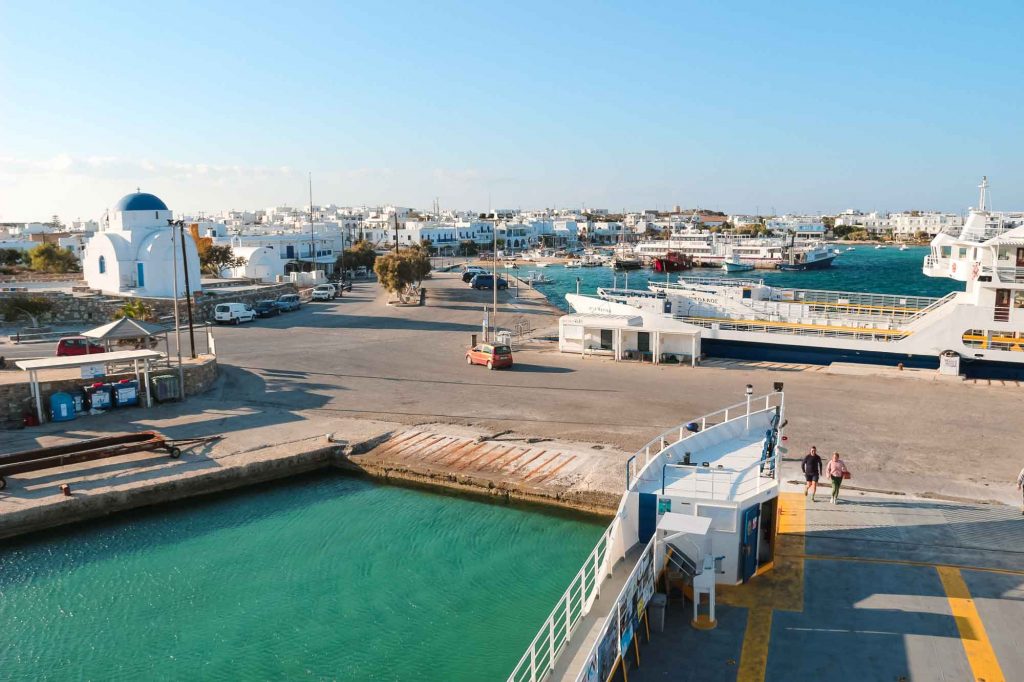
A Low-key Island-Hopping Option:
Side note: If you want to skip the ferries, go full-relax and mostly stay put, it’s still possible to see more than one island with a minimum of stress. You can always book a catamaran tour (or even a couple) starting from your home-base island and visiting others.
These are a few multi-island tours I found on Get Your Guide:
Where to Buy Greek Ferry Tickets
There is no single, official Greek ferry website, because dozens of ferry companies operate in Greece and around the Mediterranean.
Just as multiple airlines fly the same routes every day, multiple ferry companies sail the same routes with different departure times and – importantly – different speeds. The company you sail with determines the size and speed of your ferry, which can make hours of difference in your travel day, and make a big difference in your comfort if you’re prone to seasickness.
You probably don’t go straight to Delta or British Airways to check ticket prices – you start at Kayak or Skyscanner or Momondo to see what your options are. (At least that’s how I do it.)
Well, FerryHopper is the Kayak of ferry tickets in Greece, Italy, Spain, France, Turkey, Morocco, Algeria, Malta, Scandinavia and many other destination with abundant coastlines!
Here’s the map of most their destinations. (Scandinavian ferry routes aren’t highlighted on the map yet, even though you can book them with FerryHopper.)
FerryHopper map:
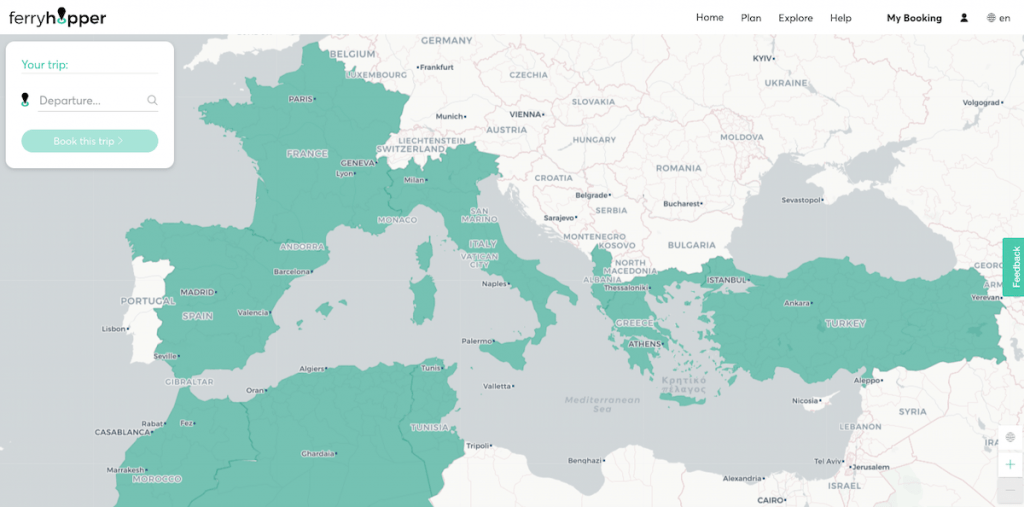
And after several uses, I was impressed by how well the site worked. This is why:
FerryHopper lets you compare routes, prices and schedules for different European ferry companies. You can buy tickets with – no markup or fee – and keep all your ticket confirmations and ferry boarding passes in one place on their app.
Trust me, this is far easier than tracking down each ferry company operating in Greece, or wherever you’re island-hopping, and checking each website individually.
After comparing with other booking sites, I think FerryHopper is the best website to book ferries in Greece. First, it doesn’t add any fees, which is unique. (FerryHopper prices are exactly the same as what the ferry companies charge directly.)
And both their website and app are very user-friendly and easy to use. (Just scroll to the bottom of their homepage for the link to download the app.)
What makes the FerryHopper app useful
I wasn’t expecting much from this app, but it was surprisingly useful! Here’s why:
- First of all, for most ferries, you can use the app to check in – meaning you don’t have to go to a ticket office at the port to pick up paper tickets. This varies slightly by the country and ferry company, but in most cases paper tickets aren’t necessary if you have the FerryHopper app.
- The app stores all of your planned trips and tickets in one place.
- It shows the departure and arrival times, delays, and the next ports of call, all in real time while you’re on the ferry. (The individual ferry companies don’t give any of that info. I know, because I asked the employees on board all of the ferries I took.)
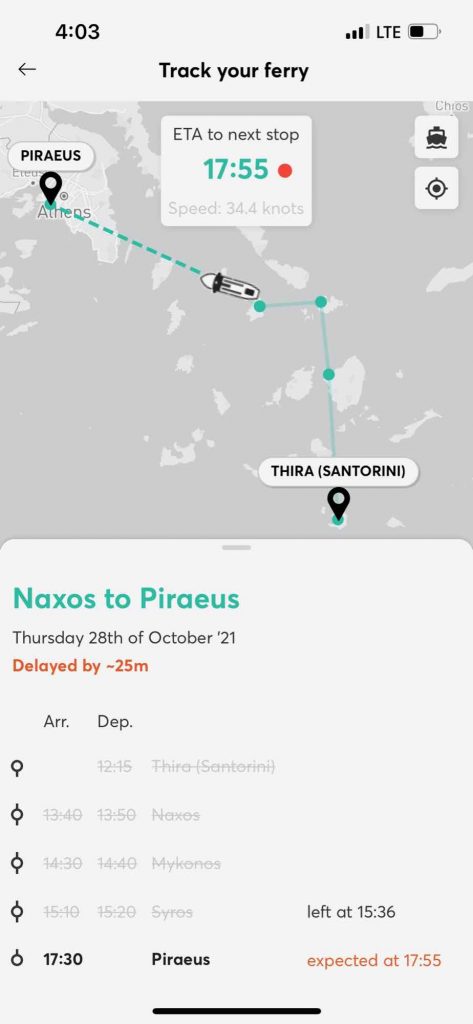
In Case You Don’t Speak Greek…
One more handy thing about FerryHopper is that you don’t have to know the name of the port where you’re going – just the island or city. That may sound silly but, for example, if you type “Athens” on the Blue Star Ferries website, it will give you zero results because you didn’t use the main port’s official name – Piraeus.
(Rafina is the other ferry port in Athens. It’s closer to the airport, but has fewer departures, and is less convenient if you’re coming from the city center.)
FerryHopper automatically gives results for both ports in Athens, even if you don’t know what they’re called.
[Related: This is also one of the reasons I recommend Omio for booking train tickets in Italy. It’s not the only way to go, but if you don’t speak the local language, it makes things more fool-proof.]

Ferry Passes & Discounts?
To dispel a myth, there’s no such thing as an “unlimited pass” for all Greek ferries.
However, EuRail does offer a Global Pass that includes a 30% discount on Blue Star ferries in Greece. And their 4- and 6-day Greece Passes let you pay one price for either 4 or 6 travel days to be used within a month.
There are some limitations (not all ferry lines are included in the pass), and it depends on the routes you’ll be taking, but these actually can be a really good deal. (The 4-day pass, for example, costs about $100, and most ferry trips in Greece that are longer than an hour or so cost more than $25.)
SCAM ALERT: Some travel companies will offer to sell you “ferry passes,” but really they’re just buying all the one-way tickets you need, and then generally overcharging you for them. Maybe “scam” is a bit dramatic, but the EURail passes are the only ones I’ve found that are a legitimate deal.
Cell Service and WiFi on Greek Ferries
Note that the real-time updates on the FerryHopper app only work if you have cell service while you’re traveling, or WiFi on the ferry. (Which I’ve been told some do, for a fee. But the ferries I took in Greece either didn’t have WiFi, or it didn’t work well.)
I do have service when I travel, because I recently switched to Google Fi, which I’ve been really impressed with! The service is excellent. It beats my husband’s T-Mobile international service almost everywhere we’ve traveled – especially in more rural areas like the Greek islands. And I don’t have to switch SIM cards when I travel anymore. (One less thing to think about, spend money on, and throw away.)
(If you want to switch to Google Fi, you can use my referral link for $20 off. And check back soon for a post about more little swaps like this one that I use to save money while traveling!)
That being said, no cell phone company will get you reception out in the open Mediterranean! My service worked well within a few kilometers from shore, but then faded as the ferry got farther away from each island.

Blue Star Ferries vs SeaJets in Greece
There are dozens of ferry companies in Greece, but the two I traveled with, SeaJets and Blue Star, are among the most common. There are some major differences between the two:
Blue Star
Blue Star is the biggest ferry company in Greece, with more departure times and larger ferries. This makes for several differences: First, Blue Star ferries feel like cruise ships, with outdoor access (weather permitting), lounge areas, and seating areas with tables on multiple floors. They also have Wi-Fi (not that it worked well when I tried it).
And being bigger means Blue Star ferries are slower, which can add hours to longer routes. But they’re also more stable, so if you’re worried about getting seasick, Blue Star is the safer bet!

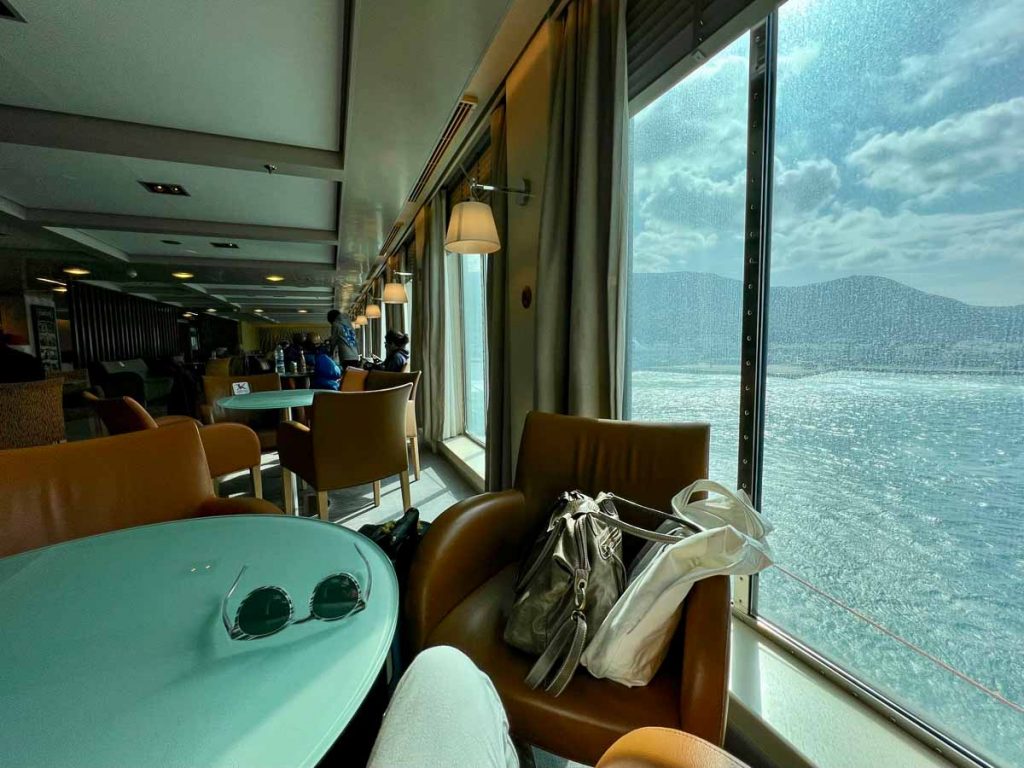
SeaJets
SeaJets’ ferries are smaller and faster than Blue Star. The Champion 2, which I took from Naxos to Athens, saved me about 2 hours of travel time compared with Blue Star.
But the SeaJets ferry had airplane-style assigned seating, and no lounges, outdoor deck access, or WiFi. Other SeaJets ferries for shorter trips, like the Andros Jet or the Caldera Vista, are even smaller.
That’s another reason to avoid SeaJets if you’re prone to seasickness – you might end up with an assigned seat in the middle of the ship. (As I did. But it was low-season, so the boat wasn’t full and I was able to move to a window seat. In July or August, that may not be so easy. On Blue Star, all the lounge areas mean you’re more likely to have easy options to move to a different area.)
On the Champion 2, there was normal seating downstairs, Club or Business class upstairs, and the fancy Platinum class back in a small corner behind closed doors.

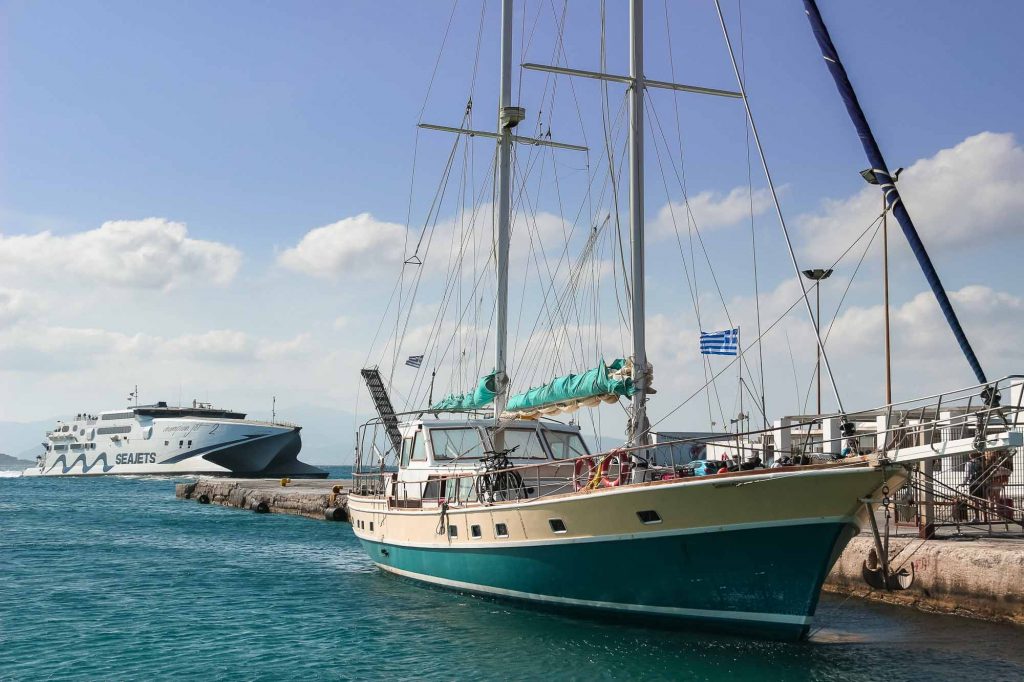

Tips for Not Getting Seasick on a Ferry
I can start feeling motion sickness on a drive to the grocery store, so I have some well-tested advice to share in this department:
- Find a seat where you can see out the window (even if you’re not right by the window).
- Look out at the horizon, not down at the waves.
- Breathe.
- Keep your gaze as steady as possible, trying to not look around at different points. Just find one thing to fix your eyes on and try to relax and only think about that spot.
- Again, breathe. Feeling like you might get sick causes stress, and stress causes holding your breath, and holding your breath just makes you feel sicker.
- Stay seated as much as you can. In my experience, walking around never helps, although being outside might. (If your ferry has an outside deck and it’s not too choppy to go out there.)
- Pack some ginger candies. I’d recommend doing everything else I’ve mentioned before counting on ginger to save you, but I used to travel with these ginger chews and I can attest that they can be soothing when you’re feeling your stomach flop around. (Ginger is the first ingredient in those, which is tough to find.) You can also try ginger hard candies, or chewable flavored tablets (for non-ginger lovers). I kind of think having a flavor in your mouth to focus on is part of what helps.

How Reliable Are Greek Ferries?
Near the end of my trip, when the weather started to turn autumnal in late October, a friend’s ferry was canceled the day before I was supposed to leave. That got me in on some local eye-rolling and gossip: Apparently this was no surprise, because the SeaJets ferries are cancelled more often than Blue Star.
That part is true, not just gossip, but I heard two different versions of why: The first was that SeaJets cancels sailings and blames it on the weather when they haven’t sold enough tickets to make it worthwhile. The more likely explanation is that the SeaJets ferries are smaller, so they can handle only smaller waves.
Either way, all the locals told me there are more cancellations in the autumn than other seasons.
As for keeping to the schedule, I found that timeliness is a vague concept in ferry travel. They’ll usually start the day on-track, leaving the first port on time. From there, it’s anyone’s guess whether the next ports of call will keep to the schedule on your ticket or not – so definitely don’t book a close connection for your flight home!
How to track your ferry in real time
This is why it’s useful to use the FerryHopper app to track your boat, so you can see if it’s actually arriving on time. That’s the simplest method.
Another option is the Marine Traffic app, which shows the location of all ships around the world in real-time, including the one you’re ticketed on. Finally, there’s a website called MyShipTracking.com that does the same thing, but in my experience it’s the clunkiest option.
Watch the weather!
Locals on Paros told me that Blue Star ferries might be cancelled when there’s a “beaufort” rating of 8 or 9, while SeaJets ferries could be called off at 6 or 7.
If the weather’s looking iffy, do as the Greeks do and check the beaufort on Poseidon, a weather website for the Mediterranean that’s apparently very accurate. (Click “surface wind” on the left, and click the colorful map legend in the bottom right to change the unit to “bft” for beaufort.)

Ferry Schedules, Booking Timelines & Dates to Avoid
Ferries in Greece run all year-around, but with varying schedules. They’re pretty regular between late March to early November (the main tourism season in Greece). And the most frequent departures are in the high-season, from June through September.
When I visited Paros and Naxos in late October, there were still multiple sailings per day for the routes I took (and also for the routes I debated taking, while I was making my last-minute travel plans!). You’ll also find much emptier ferries during that shoulder-season time of the year.
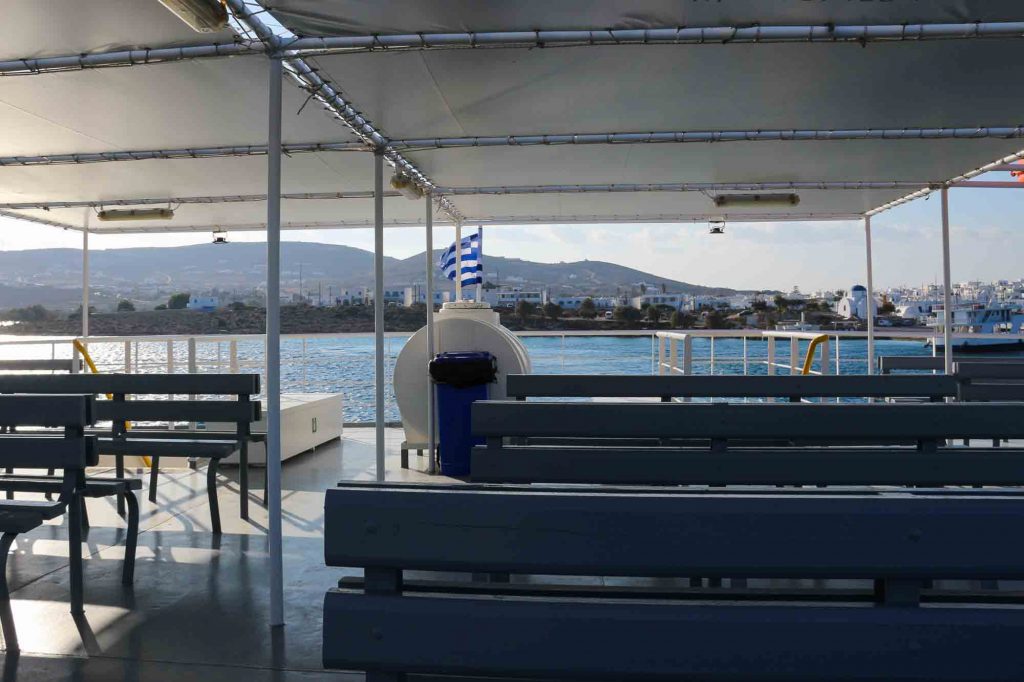
I had no problem booking tickets just a day or two in advance on my phone with the FerryHopper app, or buying them in person at the port a few minutes before departure. (Not that I’d recommend cutting it that close, but that’s one of the many reasons I love visiting popular destinations in the off-season, when the crowds are thin.)
From everything I’ve read and heard, it’s rare for the big ferries in Greece, like Blue Star, to sell-out – even in the summer. (Or at least it’s rare that all of the day’s departures for a route will sell out. You might end up on a ferry an hour later than you’d hoped, but you should be able to get to your destination.)
During the really-low-season (November through March), departures are greatly reduced and some islands aren’t even reachable.
Watch Out for Transportation Strike Dates
In both Italy and Greece, labor strikes can certainly interrupt travel, whether by plane, train, or ferry. One major travel date to avoid is May 1, when workers in Greece have a huge strike every year. There’s a high chance of cancellation if you book a ferry on that date.
(There are a few other transportation strikes throughout the year in Greece, but this is the one you can count on. And it’s quite likely to shut down ferries, along with other forms of transport. Luckily, they’re all scheduled in advance.)
In Italy, it’s a bit different. May 1st is when Italians, along with most of the world, celebrate Labor Day. So there are reduced schedules for most forms of transport, but not necessarily strikes. (In classic Italian fashion, the day is more focused on picnics, but it’s still a travel date to avoid.)

How to Go from Italy to Greece by Ferry
You can catch a ferry across the Adriatic Sea, between the East coast of Italy and the West coast of Greece all year (as long as the weather holds).
These trips come with different degrees of commitment: Bari to Igoumenitsa, for example, is a bit under 12 hours, so it would be a great choice for an overnight ferry. (Save a hotel, save a flight, and grab a cabin on the ferry with a window facing the sea! Personally, I always prefer this kind of transportation – it has so much more flavor than sticking another anonymous airport in the middle of an adventure.)
The ferry from Venice to Patras, on the other hand, is a 35-hour trip!
At 8 hours, Brindisi to Corfu is the shortest ferry route between Italy and Greece, but it’s only available in the summer.
Another handy feature on FerryHopper is that you can search by region. For example, you can browse ferries from “Italy – East Coast (all ports)” to see where you’d need to start in Italy in order to catch a ferry to Corfu, Greece.
(But remember that there are no direct ferry routes between Italy and Crete, Santorini, Mykonos, Paros, or any of the other islands in the Cyclades.)
One more tip: The EuRail 6-day Greek Island Pass also includes two international ferry tickets between Italy and Greece.

Final Tips for Your Ferry Departure Day
You don’t have to be nearly as early for your ferry trip as you do for a flight, but please remember that your ferry will not wait for you if you’re late!
I found it was best to get to the port at least 30 minutes before departure just to have time to figure out which ferry was mine. (It’s not always crystal clear, and there can be multiple docks that are several hundred yards apart.)
Before going to the port, you can check-in on your phone with the FerryHopper app.
There’s no security check to go through, and you just walk right up to the boat and get in line to board with your tickets (usually) on your phone. They’ll scan the barcode on your ticket as you get on. (If you’re wondering whether your email confirmation for your ferry tickets will get you on the boat or not, check whether it has a barcode.)
Other questions about ferries in Greece and/or in Italy? Leave them in the comments below and I’ll do my best to help!


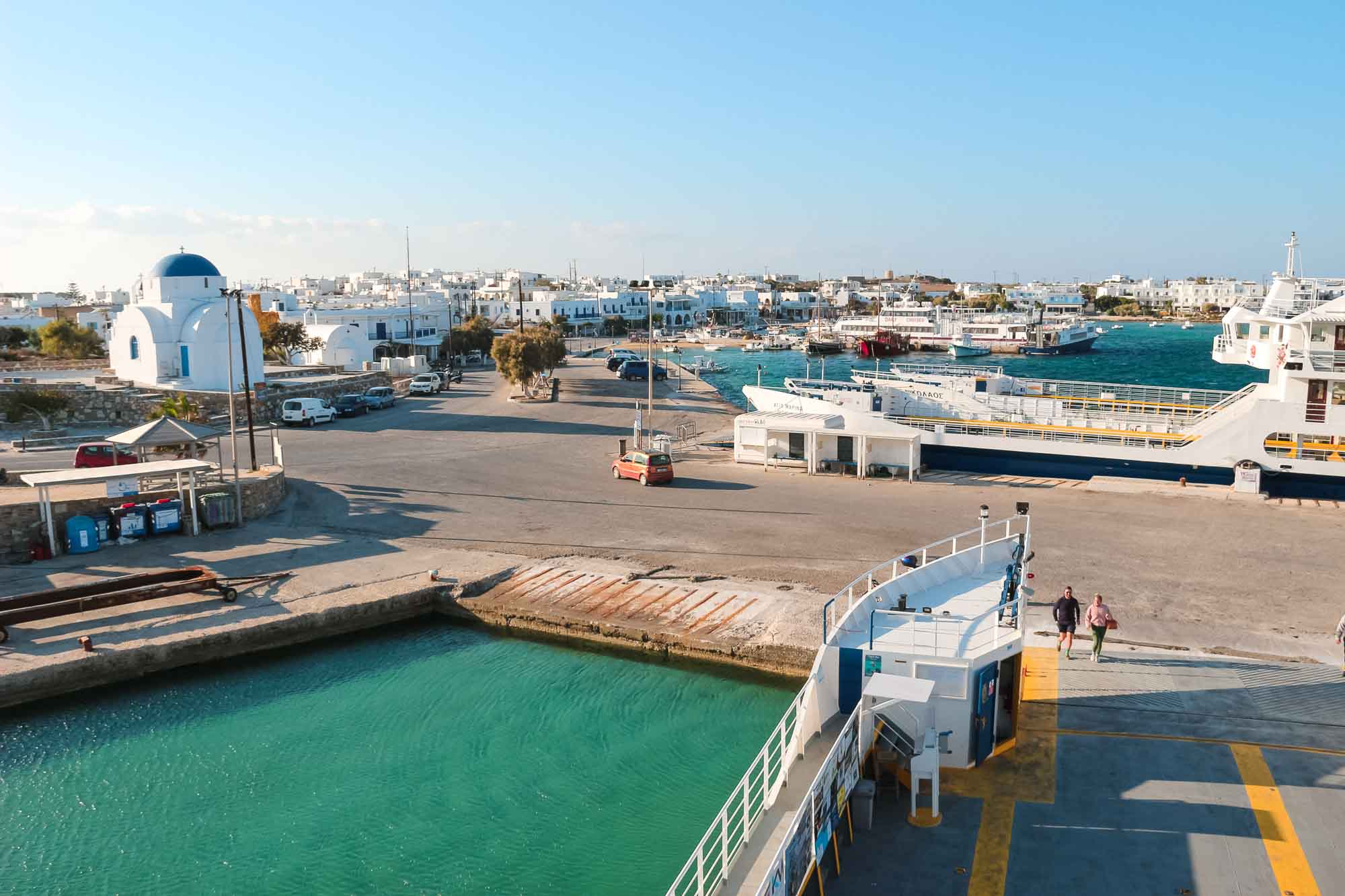


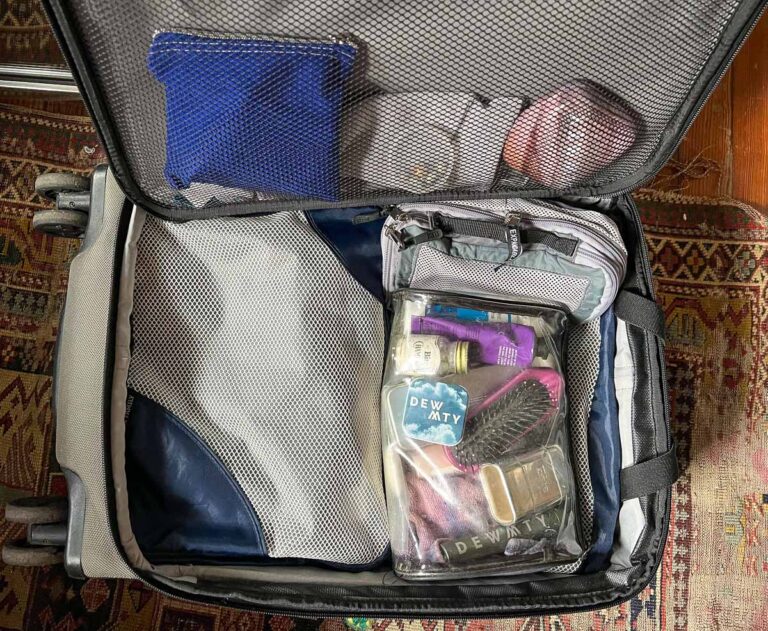



Hi Ketti
Thanks for putting this together, it’s always been a bit daunting trying to sort out ferries around the greek islands and have mostly just flown for the “ease” in the past where possible. Going to try and brave it next time though having read your tips here! Thank you!
Hi Laura,
I understand the daunting factor, and I’m so glad you found the article helpful! The ferries are definitely worth a go in Greece. 🙂
Cheers!
Ketti
This was a great read and we have just been recommended to use the Ferry Hopper for our trip next year so your article was very heloful
Hi Jeanne,
Thank you for your comment, I’m so happy to hear the article was helpful! 🙂
Also, just FYI, if you click through the FerryHopper links in my article when you buy your tickets, I can earn a commission from them. That’s a big part of how I finance this blog so that I can keep writing useful content, so if you do click through I’d appreciate it!
Hope you have a great trip, and please let me know if you have any questions! (And in case you’re thinking of going to Paros, I wrote a couple of articles about that island, here and here.)
Cheers,
Ketti
Thank you, this is really helpful. I’m leaving a cruise ship in September next year and hoping to get straight off the ship at the Piraeus port and get the ferry to Paros, but I am a bit nervous about having to pick up a paper ticket as I have read it is sometimes at a kiosk that is not near the port. I understand most companies allow scanned tickets. So hopefully it will be okay.
Hi Cheryl,
I’m so glad it was helpful! Yes, it should say in FerryHopper, before you buy your tickets, whether it’s an eticket or not. In that case, you can just keep it on your phone.
Hope you have a great trip, and let me know if you have questions about anything else! 🙂
Ketti
Hello thanks for your article on FerryHopper – very useful!
I was told that if we buy ferry tickets for a certain time, it doesn’t really matter what time we actually hop on as long as it’s on the same day- is that correct?
Hi Sandrine,
I’m really not sure about that. I’ve never heard that I would be skeptical to use that strategy – especially in the summer high season when ferries can fill up! Let me know though if you do find it to be true – now I’m curious.
Glad you found the article helpful! If you’re interested in more, please do keep in touch!
Cheers,
Ketti